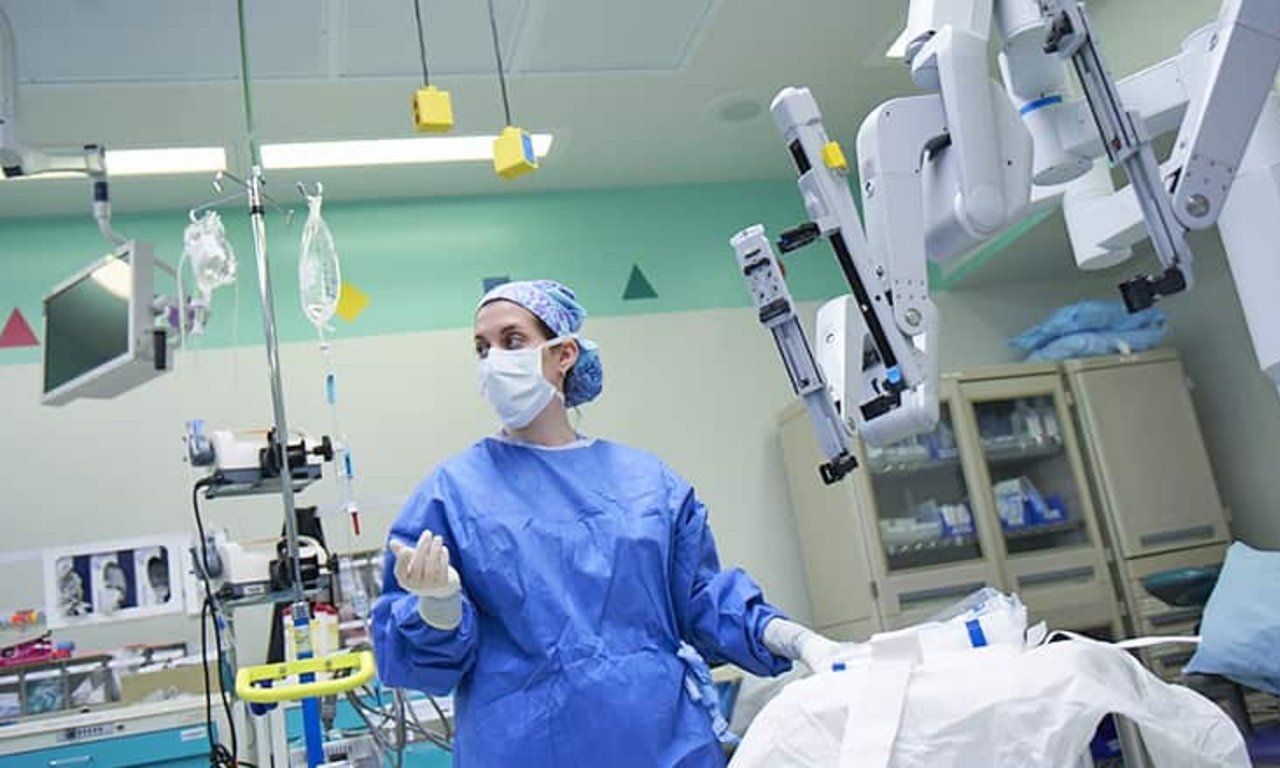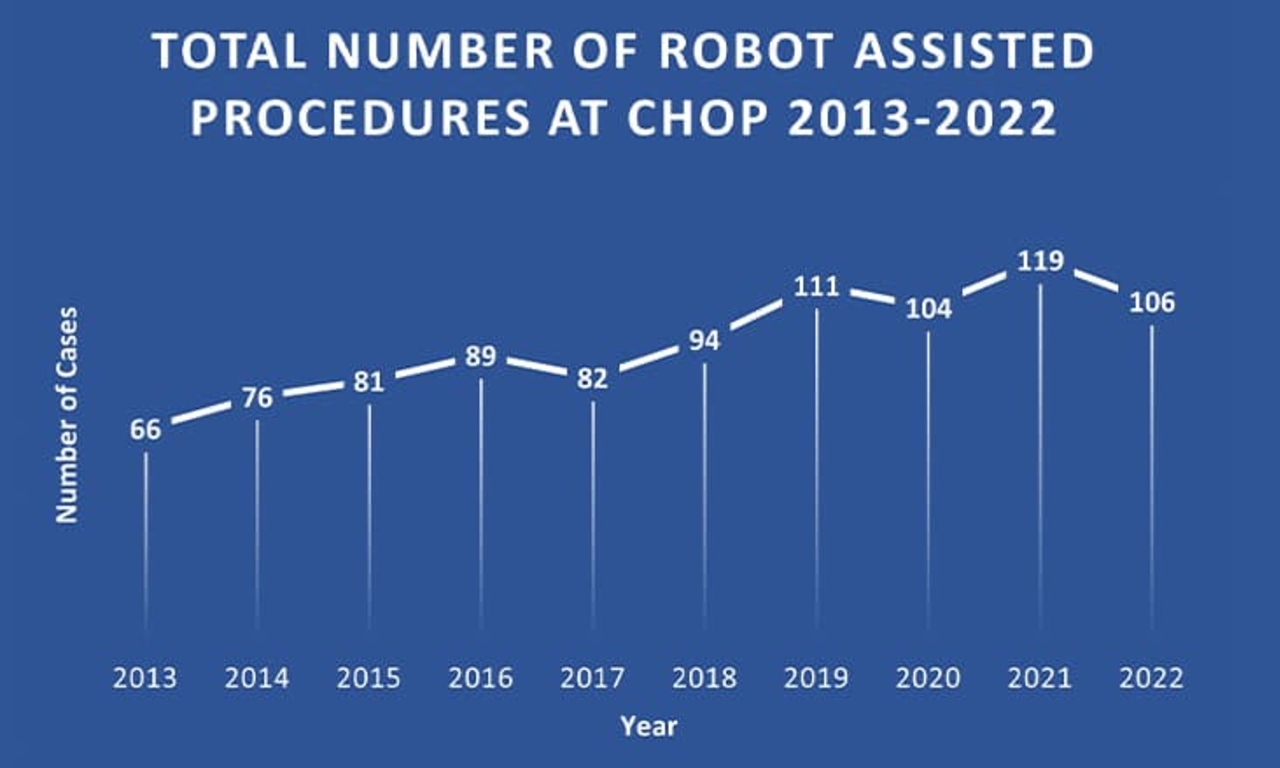Minimally Invasive Surgery in Pediatric Urology

A core team of experienced surgeons and staff is key to minimally invasive surgery in children.
Minimally invasive urologic surgery is a type of surgery that allows surgeons to operate on very precise areas of the body. It is used to treat diseases of the urinary system, including problems affecting the urinary tract, reproductive organs, bladder and kidneys.
The benefits of minimally invasive surgery for urology conditions
Because minimally invasive surgery uses smaller incisions, your child will experience less pain and scarring, and experience faster recovery as compared to standard "open" surgery, where a large incision is made. This means reduced use of opioids for pain management and shorter hospital stays.
While minimally invasive surgery has many benefits, in some cases “open surgery” techniques are still the preferred treatment method. We will partner with your family to discuss options and select the best surgical approach for your child depending on their unique health situation and condition.
The following minimally invasive surgical approaches are available to children being treated at Children’s Hospital of Philadelphia:
Robotic surgery for urology conditions

If a procedure involves complex reconstruction, a surgical robot may be used. Robotic surgery facilitates even the most difficult urologic surgical reconstruction by reproducing the hand and wrist motions of a surgeon and also providing a 3D view of the surgical field. The robot uses very fine movements resulting in minimal trauma to tissue.
Robot-assisted Urologic Surgery
Since it launched in the early 2000’s, CHOP’s robotic surgery program has led the way in creating innovative approaches to surgical reconstruction for children with complex urologic conditions. Our team has performed more than 1,500 robotic urology procedures since the program began, making it one of the most experienced pediatric urology robotic surgery programs in the world.
We perform robotic surgery for urology conditions on infants as young as two months of age, all the way through adolescence and young adulthood. Our team is devoted to providing excellent outcomes while ensuring rapid recovery and minimizing pain.
Robotic surgeries used to treat disease of the urinary system include:
- Pyeloplasty - removal of the obstructed portion of the ureteropelvic junction that prevents urine drainage from the kidneys to the ureter
- Your child will have access to state-of-the-art instrumentation and a dedicated operating room, as well as the expertise of CHOP’s specially trained pediatric anesthesiology and pain management specialists who are specially trained to understand the correct dose of medication required to control your child’s pain. Using less medication allows your child to spend less time recovering from anesthesia and reduces the chance of side effects.
- Redo pyeloplasty, including ureterocalicostomy - Redo pyeloplasty is done if the obstruction persists after primary pyeloplasty. Ureterocalicostomy involves connecting the healthy ureter with the calyx of the kidney—bypassing the persistent obstructed portion in the renal pelvic area.
- Ureteral reimplant (dismembered and extravesical) - procedure performed to change the position of the ureters (which are tubes that carry urine from the kidneys to the bladder) where they enter the bladder
- Creation of appendicovesicostomy (for neurogenic bladder) - creation of a new tube attached to the child’s abdomen which will help to drain urine. This new tube is made from the child’s appendix
- Bladder diverticulectomy - procedure performed to remove diverticula, which are pouches that are formed in the bladder due to obstruction of urine flow
- Ureterocalycostomy - connecting the healthy ureter with the calyx of the kidney – bypassing the persistent obstructed portion in the renal pelvic area
- Bladder augmentation for neurogenic bladder - Procedure performed to make the bladder bigger so that it can hold more urine - Procedure performed to make the bladder bigger so that it can hold more urine
- Partial nephrectomy - removing a diseased portion of a kidney while leaving normal kidney tissue uninjured
- Ureteroureterostomy - a procedure performed to connect two segments of a ureter to help the kidney drain urine into the bladder

Bela’s Story: Robot-assisted Ureteroureterostomy for Duplex Kidney
Treatment for duplex kidney and ureterocele spanned from before birth to a robotic surgery.
Laparoscopic urology surgery

Laparoscopic urology surgery is a type of minimally invasive surgery that enables surgeons to operate on very precise areas of the body. In laparoscopic surgery, several tiny incisions are made through which narrow tubes are inserted. Surgical instruments and cameras are passed through these tubes, allowing the surgeon to see and perform delicate procedures.
Our team performs single-site, retroperitoneal and transperitoneal laparoscopic surgeries. Laparoscopic surgeries are performed for undescended testicles, hernias and/or hydroceles, removal of a kidney, removing part of non-functioning kidney, etc. A surgical robot assists with certain laparoscopic surgeries.
Laparoscopic urology procedures offered at CHOP include:
- Orchiopexy - surgery for undescended testis
- Hernia repair - procedure performed to repair inguinal hernia, which is an opening near the groin area where fluid or intestines can pass through
- Partial nephrectomy - removing a diseased portion of a kidney while leaving normal kidney tissue uninjured
- Total nephrectomy - complete removal of a diseased kidney
- Nephroureterectomy - complete removal of diseased kidney and ureter
- Pyeloplasty - removal of the obstructed portion that prevents urine drainage from the kidneys to the ureter
- Ureteral reimplant - a procedure that alters where the ureters enter the bladder wall in order to prevent reflux of urine back into the kidneys and to improve urinary flow into the bladder
- Removal of renal cyst - procedure to remove a renal cyst, a pouch filled with fluid that forms in the kidney
- Single-site laparoscopy- removal of diseased organ through a single small incision
Endoscopic urology surgery
In endoscopic urology procedures, we use tiny cameras with a working channel (scopes) that enter the urinary system through natural openings in the body like the urethra, which eliminates the need for skin incisions. The surgeon looks at a video screen, which displays the magnified images of the body's internal structures. The surgeon moves the endoscope in the organ system and operates with thin, precise instruments.
Our team performs endoscopic surgery primarily to manage kidney stones, calyceal diverticulum, ureteroceles, and low-grade vesicoureteral reflux.
Keeping your child safe while achieving the best possible outcomes is our top priority when performing endoscopic urology procedures in children. We use the most advanced technology and surgical instruments specially designed for use in children, including digital ureteroscopes, ultrasound guidance and laser technology. These tools help us avoid unnecessary exposure to radiation and reduce the time a child is under anesthesia, further improving the safety and success of the procedure.
Endoscopic urology surgeries include:
- Urethroscopy - procedure done to visualize the urethra, a hollow tube that drains urine collected in the bladder, using a telescope
- Cystoscopy, including valve resection - procedure performed in which a cystoscope (instrument used to visualize the urinary tract) is inserted and used to remove excessive valve tissue that is causing the urethral obstruction- final canal that will drain the urine from the body
- Deflux injection into bladder - alternative procedure performed for reflux whereby a gel-like mixture is injected where the ureter (tubes that carry urine from the kidney to the bladder) joins the bladder. This will add a bulk at the insertion site and will reduce the backward flow of urine.
Endoscopic urology surgeries to treat kidney stones:
- Ureteroscopy – In a ureteroscopy, a long, thin fiberoptic telescope (ureteroscope) is inserted through the urethra and passed through the bladder to the kidney stone. It is used to remove or break up (fragment) stones with a laser. A small tube (or stent) may be left in the ureter for a few days after treatment to promote healing and prevent blockage from swelling or spasm. This is performed in an outpatient setting.
- Percutaneous nephrolithotomy (PCNL) – Percutaneous (through needle-puncture of the skin) removal of kidney stones (lithotomy) is accomplished by threading various catheters directly into the kidney and manipulating surgical instruments through the catheters to fragment and remove even the largest kidney stones. This procedure usually requires hospitalization and most patients resume normal activity within two weeks.
- Lithotripsy – This procedure is effective for stones in the kidney or upper ureter. It uses an instrument, machine or probe to break the stone into tiny particles that can pass naturally. Lithotripsy is not appropriate for patients with very large stones or other medical conditions. This is performed in an outpatient setting.
Why choose CHOP for pediatric minimally invasive urology surgery?
A global pioneer in adapting minimally invasive surgery to the care of children with urologic diseases, the Division of Urology at the Children’s Hospital of Philadelphia (CHOP) offers the most innovative and comprehensive care for various urologic conditions and diagnoses requiring surgery.
Children’s Hospital of Philadelphia is one of the busiest minimally invasive pediatric urologic surgical centers in the country, with hundreds of patients treated each year.
Our team of experts includes world leaders in urologic surgery who are constantly seeking to improve care, find new treatment options and improve outcomes. We are actively involved in clinical research, safety and quality improvement programs.